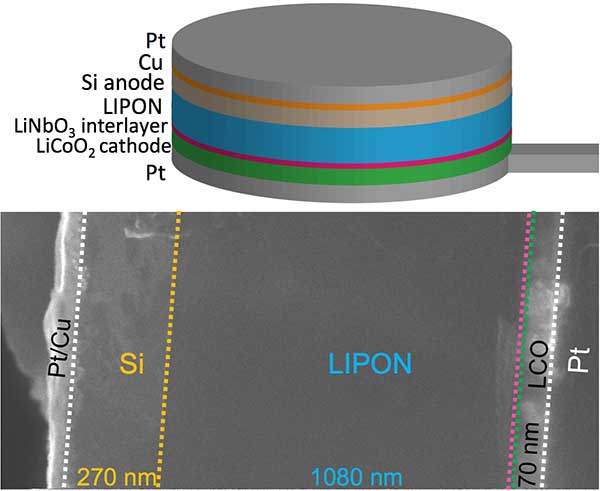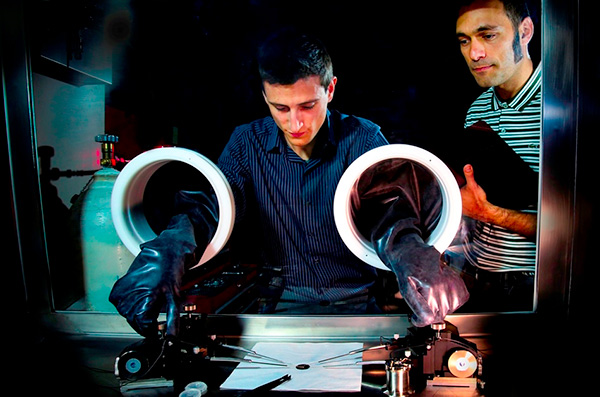Sandia researchers make solid ground toward better lithium-ion battery interfaces
Research at Sandia National Laboratories has identified a major obstacle to advancing solid-state lithium-ion battery performance in small electronics: the flow of lithium ions across battery interfaces.
Sandia’s three-year Laboratory Directed Research and Development project investigated the nanoscale chemistry of solid-state batteries, focusing on the region where electrodes and electrolytes make contact. Most commercial lithium-ion batteries contain a liquid electrolyte and two solid electrodes, but solid-state batteries instead have a solid electrolyte layer, allowing them to last longer and operate more safely.
“The underlying goal of the work is to make solid-state batteries more efficient and to improve the interfaces between different materials,” Sandia physicist Farid El Gabaly says. “In this project, all of the materials are solid; we don’t have a liquid-solid interface like in traditional lithium-ion batteries.”
“Our focus wasn’t on large batteries . . . It was more for small or integrated electronics.”
The research was published in a Nano Letters paper titled, “Non-Faradaic Li+ Migration and Chemical Coordination across Solid-State Battery Interfaces.” Authors include Sandia postdoctoral scientist Forrest Gittleson and Farid, members of the Materials Physics department. The work was funded by the Laboratory Directed Research and Development program, with supplemental funding by the Nanostructures for Electrical Energy Storage Energy Frontier Research Center within the DOE’s Office of Science.
Farid explains that in any lithium battery, the lithium must travel back and forth from one electrode to the other when it is charged and discharged. However, the mobility of lithium ions is not the same in all materials and interfaces between materials are a major obstacle.
Speeding up the intersection
Farid compares the work to figuring out how to make traffic move quickly through a busy intersection.
“For us, we are trying to reduce the traffic jam at the junction between two materials,” he says.
He likened the electrode-electrolyte interface to a tollbooth or merge on a freeway.
“We are essentially taking away the cash tolls and saying everybody needs to go through the fast track, so you’re smoothing out or eliminating the slowdowns,” he says. “When you improve the process at the interface you have the right infrastructure for vehicles to pass easily. You still have to pay, but it is faster and more controlled than people searching for coins in the glove box.”
There are two important interfaces in solid state batteries, he explained, at the cathode-electrolyte junction and electrolyte-anode junction. Either could be dictating the performance limits of a full battery.
Forrest adds, “When we identify one of these bottlenecks, we ask ‘Can we modify it?’ And then we try to change the interface and make the chemical processes more stable over time.”
Sandia’s interest in solid-state batteries

Schematic of full battery cell architecture and cross-sectional microscopic image of the actual battery. (Image courtesy of Sandia National Laboratories)
Farid says Sandia is interested in the research mainly because solid-state batteries are low maintenance, reliable, and safe. Liquid electrolytes are typically reactive, volatile, and highly flammable and are a leading cause of commercial battery failure. Eliminating the liquid component can make the devices perform better.
“Our focus wasn’t on large batteries, like in electric vehicles,” Farid says. “It was more for small or integrated electronics.”
Since Sandia’s California laboratory did not conduct solid-state battery research, the project first built the foundation to prototype batteries and examine interfaces.
“This sort of characterization is not trivial because the interfaces that we are interested in are only a few atomic layers thick,” Forrest says. “We use X-rays to probe the chemistry of those buried interfaces, seeing through only a few nanometers of material. Though challenging to design experiments, we have been successful in probing those regions and relating the chemistry to full battery performance.”
Processing the research

The research was conducted using materials that have been used in previous proof-of-concept solid-state batteries.
“Since these materials are not produced on a massive commercial scale, we needed to be able to fabricate full devices on-site,” Farid says. “We sought methods to improve the batteries by either inserting or changing the interfaces in various ways or exchanging materials.”
The work used pulsed laser deposition and X-ray photoelectron spectroscopy combined with electrochemical techniques. This allowed very small-scale deposition since the batteries are thin and integrated on a silicon wafer.
“Using this method, we can engineer the interface down to the nanometer or even subnanometer level,” Forrest says, adding that hundreds of samples were created.
Building batteries in this way allowed the researchers to get a precise view of what that interface looks like because the materials can be assembled so controllably.
Demonstrating performance of solid-state batteries
The next phase of the research is to improve the performance of the batteries and to assemble them alongside other Sandia technologies.
“We can now start combining our batteries with LEDs, sensors, small antennas or any number of integrated devices,” Farid says. “Even though we are happy with our battery performance, we can always try to improve it more.”